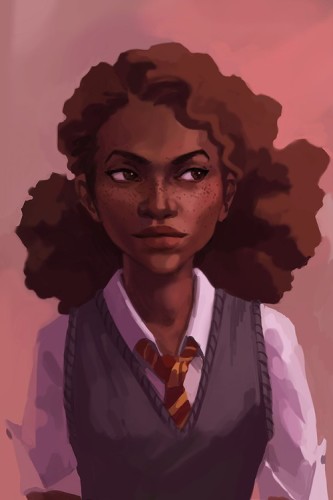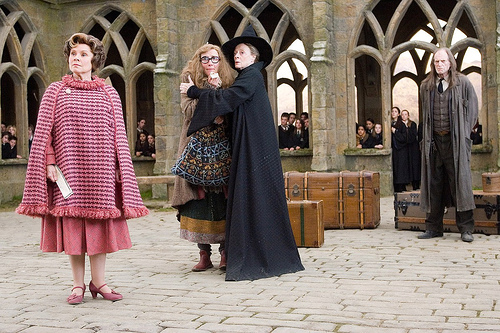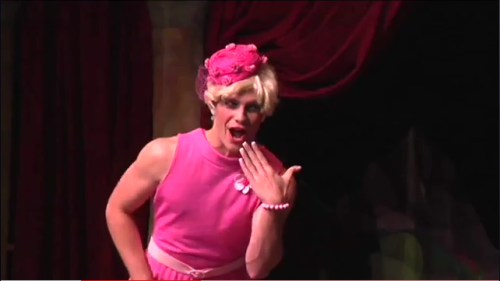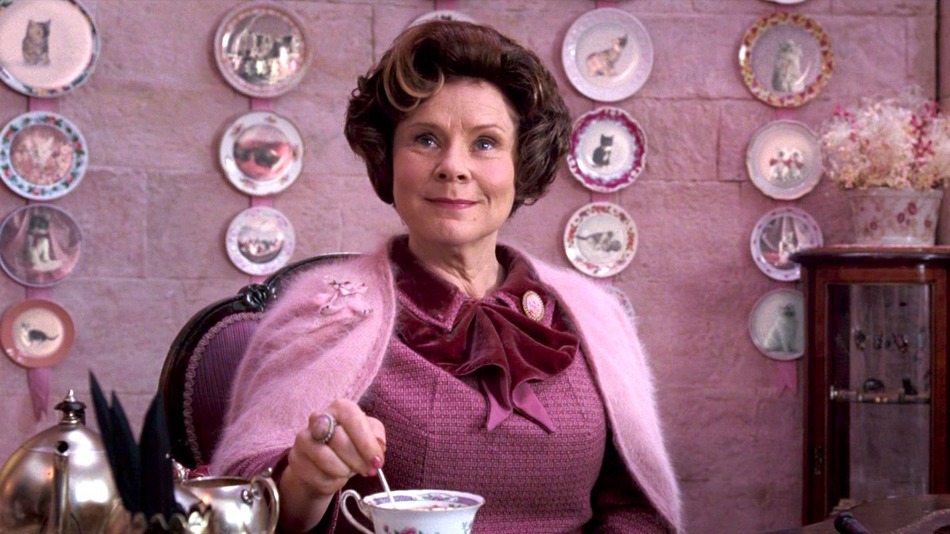Written by Jackson Adler as part of our theme week on Unlikable Women.
When I saw the words “Unlikable Women” in regard to this Theme Week, I immediately thought of Dolores Jane Umbridge from the Harry Potter franchise. Umbridge works as Undersecretary to Minister of Magic Cornelius Fudge. Through her position in the patriarchal wizarding government, Umbridge enables job discrimination, segregation, incarceration and harsh sentencing, and physical violence and genocide against marginalized people. She not only politically supports these efforts, but personally enacts violence against marginalized people and their allies, including children. She is assigned by the ministry to be the Defense Against the Dark Arts professor in Harry’s fifth year of schooling, and also as the Hogwarts High Inquisitor to make sure that the school is run how the ministry desires. Umbridge was already representative of every person to was put in a position of power and trust who abuses that power and trust for their own self interest and sense of self worth and enjoyment. Many children have experienced such ill behavior from teachers, though hopefully not to the same extent as Umbridge treats her students, and Umbridge is arguably the most hated Harry Potter character by the fandom. However, when they vocally condemn the character, fans don’t always list the many violent actions the character condones and practices, but instead often insult Umbridge for her looks, for her love of pink, for her age, for her size, and for her love of cats, getting some form of satisfaction from this sexism and ageism against a character they despise so much. This is certainly problematic, especially since by condemning these aspects of this cruel character, they condemn middle-aged and older women as a whole, including the talented actress Imelda Staunton who plays her in the films. Also, overlooking Umbridge’s oppression of marginalized groups (even the ones to which she belongs) is erasure, which in itself is a violent act and promotes other violent acts, of marginalized groups and their experiences. While merpeople, werewolves, and centaurs do not exist in the real world, the ways in which they are marginalized and attacked in Harry Potter are very real for many people around the world and throughout time, including those being persecuted today.
On J.K. Rowling’s website Pottermore, “the place to explore more of the magical world of Harry Potter than ever before and to discover exclusive new content from J.K. Rowling,” Rowling has confirmed that Dolores Jane Umbridge is “half-blood,” and provided more of the character’s background. While not entirely a surprise for fans, it confirms that the Umbridge in the Harry Potter books sets herself against those with whom she has shared lived experiences as both a female non-“pureblood,” making her more culpable than many of the other villains in the story, who have largely lived in ignorance and privilege since childhood, such as Bellatrix Lestrange. There is a strong correlation between “blood status” in the wizarding world and racism in our world, and I believe that Umbridge is representative of a Biracial Black and White woman who claims only Whiteness and helps the White patriarchy in its violence against people of color, especially fellow women of color, and their allies in an attempt to gain power and decrease its marginalization of her own life.

The British wizarding society in Harry Potter is in many ways more equal in terms of gender and race than real world Britain and America. While characters in the book series still face microaggressions (and occasionally stronger discrimination) due to their gender or ethnic makeup, it seems that J.K. Rowling wanted to create a (somewhat) diverse cast of characters whose abilities are not (typically) questioned due to their gender and/or ethnicity, similar to Shonda Rhimes’ approach to casting for Grey’s Anatomy. Sadly, those who cast the Harry Potter films mostly cast White actors, and screenwriter Steve Kloves and the many directors of the film series limited the lines and character development of White female characters and male and female characters of color. The role of Dean Thomas would probably not have gone to Alfred Enoch, and been given to a White actor instead, had Rowling not insisted that the character is Black to director of the first two films Chris Columbus, who she described as “slightly taken aback” by the amount of background information she had for the character. Despite the casting of Emma Watson, much of the fandom sees main female character Hermione Granger as a woman of color, usually Black or Black and White Biracial, and some see Harry himself as Biracial, usually Black and White. Race and gender are (almost) non-issues for most witches and wizards in J.K. Rowling’s story, but discrimination itself is still a strong topic, just often in regards to fantasy creatures in place of people of color. This can be interpreted as dehumanizing the lived experiences of people of color, and while it can be argued that J.K. Rowling’s approach puts the focus more on the actions of the oppressors than on the bodies of the oppressed, thereby possibly avoiding victim-blaming or grief porn, there is a strong tradition of White sci-fy and fantasy authors appropriating the experiences of people of color to add drama to their whitewashed stories, and however good her intentions may have been, Harry Potter still falls into that trend in many ways. However, the main topic of discrimination in Harry Potter is “blood status,” the story’s middle ground between the Grey’s Anatomy-style representation and the appropriation of people of color’s lived experiences of oppression.
In the wizarding world, many witches and wizards look down on muggles (people with no magical abilities), and believe that the fewer muggles in one’s lineage, the better. Witches and wizards who come from muggle families are called “muggle-borns” or by the highly discriminatory “mudblood,” and are considered by many to be just as inferior as muggles. “Half-bloods” are more generally accepted, though they still face some discrimination, and in order to be successful in wizarding society, many “half-bloods” play up their wizarding lineage, or deny that they have any muggle lineage at all, thereby claiming to be “pureblood,” such as in the case of Dolores Jane Umbridge. Rowling’s use of “blood status” in the wizarding world can easily be compared to peerage in Great Britain, and while it is not a requirement of “blood purity”/peerage that a “pureblood”/peer have no people of color in their lineage, or that they are wealthy, it remains that Whiteness and wealth often go hand in hand with “blood purity”/peerage. The first character the reader meets in the series who vocally prides himself on being “pureblood” is Draco Malfoy, who has a “pale” face, “white-blonde hair,” “cold grey eyes,” is from an incredibly wealthy family, lives in a mansion, has two devoted parents, a servant (just one is enough, as Dobby is a talented house elf capable of powerful magic), and is overall a clear representation of a child raised and wrapped up in privilege. White patriarchal Draco is the first character we hear use the word “mudblood,” and he uses it against Hermione Granger, who, again, is often and can easily be seen as a Black girl. She is described as having “bushy brown hair,” has brown eyes, and is the first to voice that house elves are “slaves,” taking the shocking revelation that Hogwarts runs on slave labor quite personally. Pansy Parkinson, the eventual girlfriend of Draco Malfoy, often teases Hermione about her hair, and also teases Angelina Johnson (who is indisputably Black) about her hair, going so far as to say that Angelina’s braids look like “worms coming out of [her] head.” Draco also teases Hermione about her hair, and in a chilling scene in Harry Potter and the Goblet of Fire in which Lord Voldemort’s supporters start marching through a huge wizarding event, openly torturing muggles, Draco says to her “Keep that big bushy head down, Granger” if she doesn’t want to be attacked by Death Eaters (of which Draco’s father Lucius is one) and be forced to “show[…] off [her] knickers in midair,” though it would “give us all a laugh.” In this scene, he is saying to her that she needs to be submissive, or that she will be forcibly, and possibly sexually, assaulted by his father and his father’s friends. The first time, and every time after, that Draco calls Hermione a “mudblood” there are strong racial overtones specific to violence against Black women, and it carries throughout the entire series, and especially into scenes such as the one described above.
“Blood status” is then a thinly veiled metaphor for race in the Harry Potter series, and most often in terms of Black and White. Dolores Umbridge claims that she is “pureblood,” and enjoys the privileges of passing as such. Umbridge grew up with a wizarding father who worked as a janitor, and a muggle mother. Umbridge lived the intersectional oppressions of race, class, and gender. Umbridge’s sadism is compared to Bellatrix Lestrange’s by Rowling, and they share further similarity by their devotion to patriarchal figures, with Umbridge’s devotion to Cornelius Fudge, and Bellatrix’s to main villain Lord Voldemort. As Audre Lorde states in “Age, Race, Class, and Sex: Women Redefining Difference,” “white women face the pitfall of being seduced into joining the oppressor under the pretense of sharing power.” Umbridge also “face[s] [this] pitfall” by metaphorically only claiming her White/wizarding lineage. This is because “For white women there is a wider range of pretended choices and rewards for identifying with patriarchal power and its tools.” Audre Lorde further explains “It is eas[y] […] for white women to believe the dangerous fantasy that if you are good enough, pretty enough, sweet enough, quiet enough, teach children to behave, hate the right people, and marry the right men, then you will be allowed to co-exist with patriarchy in relative peace-“. Umbridge certainly internalizes this fantasy, using her “girlish” laugh, dressing herself and her office overtly and extremely feminine, and by the way in which she chooses to teach her students. Bellatrix is not only “pureblood”/White, but is naturally conventionally attractive. As Rowling states, she marries a man she does not love, taking “a pureblood husband, because that was what was expected of her,” though “her true love was always Voldemort,” albeit as obsessive form of love, which I think is more like that created by Stockholm Syndrome. Much like White women’s relationship with the patriarchy, Voldemort had no love for Bellatrix, loving “only power and himself,” “value[ing] people whom he could use to advance his own objectives.” Lord Voldemort and his Death Eaters are more openly violent than the ministry, though the Ministry of Magic has many of the same biases as Voldemort, and are more discrete in how they treat those they deem inferior to themselves. Cornelius Fudge is “blinded by the love of [his] office” to what is best for the wizarding community at large, as Dumbledore states in the novel of Harry Potter and the Goblet of Fire. Fudge and the ministry most likely overlook Umbridge’s sadism because, on the surface, she comes across as unthreatening to their privilege. She plays into the single, middle-aged cat lady stereotype, and constantly compliments and supports Fudge in order to gain favor.

Umbridge finds an enemy in Professor Minerva McGonagall, whom Rowling has revealed on Pottermore to also be “half-blood,” as well as a feminist. McGonagall works closely with Albus Dumbledore, a known ally to all marginalized groups in the wizarding world. Professor Dumbledore uses his White male/wizard privilege to uplift the talented women/witches around him, as well as that of marginalized people of all genders, giving the deserving McGonagall the position of Deputy Headmistress. Umbridge has had to resort to less direct means to get favor from the patriarchal ministry, including become extreme in her violence against those against whom the ministry is biased, including fellow female non-“purebloods.” McGonagall, who usually shows solidarity with her fellow female colleagues, frequently makes her ill feelings towards Umbridge clear, and is unabashedly happy when Umbridge is forced to leave the school. Due to their ages, it is likely that McGonagall either taught or attended school with Umbridge, and she and Dumbledore are further threats to Umbridge due to their knowledge of her past and her “blood status.” Umbridge is therefore relentless in her ambition to gain and then use authority over McGonagall and Dumbledore. Though betrayal and loyalty to “blood status”/race is not as much of a theme in the relationship between Umbridge and McGonagall in the films, especially as both actresses are White and Rowling’s biographical information on the characters may not have been known by most of the film team, Imelda Staunton and Maggie Smith portray the resentment and anger between two opposing women well. Maggie Smith’s McGonagall is particularly supportive of Emma Thompson’s Professor Trelawney, opposing Imelda Staunton’s Umbridge in her ill treatment of other women. Their characters are then representative of White women who support the patriarchy, and White (perhaps even intersectional) feminists.
J.K. Rowling’s biography of the Umbridge on Pottermore reveals a bit of how the character developed resentment, ambition, and cruelty. However, the Harry Potter film series does not contain such extra information. In the books, it is left up to the reader to decide if Umbridge truly believes the things she says, or if she is merely doing whatever it takes to keep and gain power. In the films, Imelda Staunton’s performance as Umbridge is absolutely terrifying in her sincerity of every discriminatory word she utters, every belief she claims to possess, and in every new rule and punishment she enforces. Her self-righteousness is reminiscent of White female conservative Christians who feel incredibly justified in her hate and discrimination, a sort of person with whom Rowling is perhaps particularly familiar, as she had faced discrimination from fellow Christians for raising her first child alone for a number of years. In interviews for Harry Potter and the Order of the Phoenix, in which the character of Umbridge first appears, Staunton states that she and her director worked closely to make sure that Umbridge came across as a multi-faceted and realistic character. In the scene in which Umbridge first forces Harry to write in his own blood “I must not tell lies,” the book Umbridge merely comes across as bullying, cruel, and sadistic, taking true pleasure in Harry’s pain. However, when both characters are seen as “half-blood”/”Biracial,” Umbridge’s actions can be seen as an attempt to educate a young Biracial boy in how to get by and get ahead in a world dominated by White patriarchy. Staunton plays up Umbridge as an attempted mentor to her students, even though Staunton and most of the actors playing her students are White. When Staunton’s Umbridge forces Harry to write in his own blood, she seems nervous, upset, and sad at the violence she is about to inflict upon him. However, she comes to the decision that such a drastic measure is necessary for the good of the wizarding world, and even to Harry himself. She wants the lesson to “sink in” that what he did was “wrong.” In an interview on the DVD for Harry Potter and the Deathly Hallows Part 1, Staunton reveals that her Umbridge is “making the most of what little power she has, [and] she will hang onto it […] until her last breath,” and, evidently, also onto her convictions. In the film Harry Potter and the Order of the Phoenix, again playing up the connection to White female conservatism, this includes the right to dictate the sexual and romantic behavior of the students. Staunton’s Umbridge’s belief that supporting the patriarchy is the right thing to do, including the right thing to do for women and girls, which adds extra conflict to her arguments with Maggie Smith’s McGonagall and Emma Watson’s Hermione Granger.

Another interpretation of Umbridge is that in Starkid Productions’ A Very Potter Sequel, the second of three musical parodies of Harry Potter franchise viewable on Youtube, and highly popular among the fandom. While not entirely feminist, Starkid does delve into the sexism that Umbridge undoubtedly must face in her day-to-day life, and the unhealthy way in which she copes with it. While J.K. Rowling compares Umbridge’s loyalty to Fudge with fellow sadist Bellatrix Lestrange’s loyalty to Lord Voldemort, Starkid Productions compares Umbridge with Hermione, with the common thread not being sadism, but the sexism faced by both from their male peers. Like Staunton’s Umbridge, Starkid’s Umbridge plays up Umbridge’s attempted mentorship of her students, especially in regards to Hermione. This is representative of what Brigit McCone describes in “Reclaiming Conch: In Defense of Ursula, Fairy Octomother,” with older female characters’ lessons often being important to the growth of female characters, though patriarchal storytelling reconfiguring these characters as villainesses instead of mentors/fairy godmothers. In the books and films, Hermione has this mentorship split between McGonagall and Umbridge, with them being similar to the nice mother and evil mother tropes described in Katherine Murray’s post “Child-Eating Parents in Into the Woods and Every Children’s Story Ever.” Starkid’s A Very Potter Sequel is void of McGonagall, and Umbridge takes on more of a multi-faceted role as attempted mentor to Hermione. Umbridge even gives life lessons to her female students, including Hermione, upon first meeting them, informing them of “the way the world works” for “frumpy” girls and women, and saying that she will be there “mama.” Umbridge is played by Joe Walker, who also plays Voldemort in the musical trilogy, and while the character being played by a cisgender man causes some potentially dangerous mixed messages, it does emphasize the harm both Voldemort and Umbridge has caused Harry Potter, with both being the only characters in the books to leave lasting scars on Harry, and also emphasizes the way in which the fandom relates to the two villains. Though both Umbridge and Hermione are again played by White actors, their physical and emotional similarities are explored in a way similar to how they could have been further explored in a film version that saw the characters as Biracial able to “pass” as White and a Black girl attempting to find her way in a White patriarchal world. Starkid’s Hermione claims about herself and Umbridge that “We’re both ugly, we’re both bossy, and nobody likes us,” showing how internalized unrealistic (and White) standards of beauty are internalized, how the assertiveness and confidence of women is erased by claims that they are “bossy,” and how reinforced these ideas are in every day life within a (White) patriarchal culture. Sadly, the characters’ needs for self-validation by White men is emphasized in Starkid’s production, with Ron and Hermione’s condescending monologues to Hermione about self-acceptance (undermined by their hope to gain a homework tutor/romantic partner), and Umbridge only finding happiness after rape by centaurs (no, really). Umbridge’s rape is somewhat representative of empowerment via rape fantasy, such as described in Brigit McCone’s “Blurred Lines: The Cinematic Appeal of Rape Fantasy,” though this positive interpretation of rape is still incredibly harmful, as McCone also describes. In the books, however, it is through gender and racial solidarity that lead to the defeats of Umbridge, the Minitry, Bellatrix, and Lord Voldemort.
Umbridge is a complicated character in each form of media she inhabits, and though her violence and discrimination is hateful, she is a woman (of color) trying to navigate through a (White) patriarchal world. She is successful in gaining (some) privileges for herself due to her actions, though at the expense of fellow non-“pureblood”/White women and other marginalized groups. Dumbledore claims that “it is our choices […] that define who we really are, far more than our abilities,” and yet this quote of his mentions nothing of the effect that circumstances can have in affecting life choices. Though circumstances do not entirely excuse her crimes against marginalized groups, and she is rightfully arrested and imprisoned after the defeat of Lord Voldemort, as confirmed by Rowling via interview and Pottermore, excusing her violence as merely innate is ignoring the way in which society institutionally encourages that sort of behavior. Hopefully a more thorough understanding of the character encourages a more thorough understanding of the ways in which society and individuals inhibit human rights, especially those of women of color.
